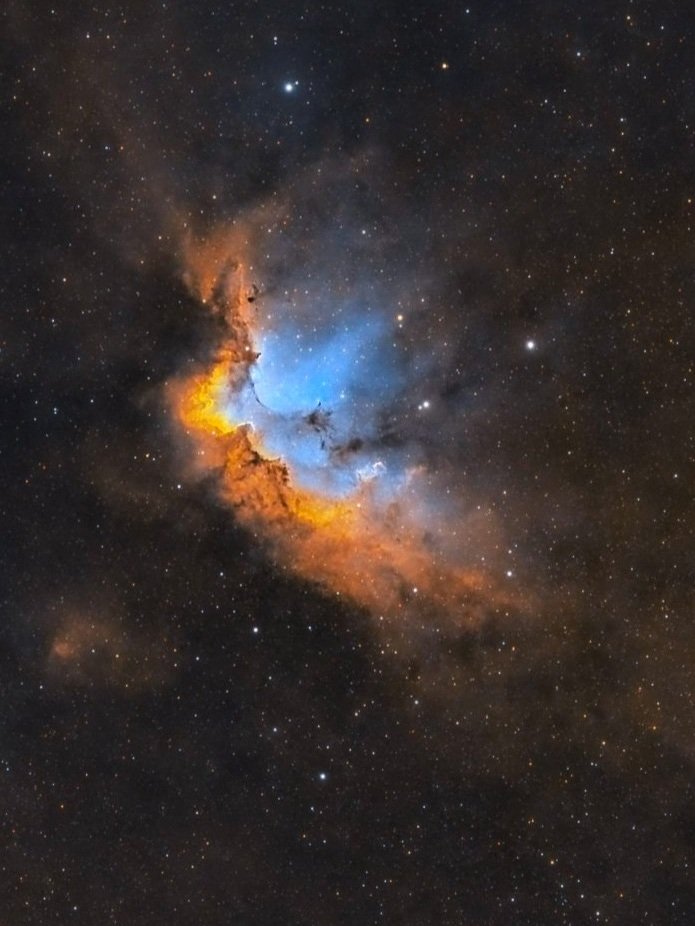The Night Sky - Episode 14
THE WIZARD NEBULA
This is episode 14 in my series on our night sky.
Nestled amidst the vast expanse of the cosmos lies NGC7380, a celestial masterpiece renowned as the Wizard Nebula. Within the annals of astronomical records, it bears the official designation within the New General Catalogue (NGC). The nebula's whimsical alias, the Wizard Nebula, emanates from its striking resemblance to a mystical figure, adorned with tendrils of gas and dust that intricately mirror the robes of an enigmatic sorcerer. This captivating name encapsulates the fascination and allure that beckons astronomers and stargazers to witness its ethereal presence in the night sky.
An image of the Wizard Nebula (NGC 7380). Over 19 hours of light from deep space was painstakingly captured to create this image.
Image by Achint Thomas
The Wizard Nebula, a cosmic tapestry spanning approximately 110 light-years in diameter, boasts an inherent luminosity emanating from the effervescent glow of its youthful stars. At a mere age of about 5 million years, this stellar marvel resides at a distance of approximately 7,200 light-years away from our humble vantage point on Earth. Situated within the grand spiral arms of our Milky Way galaxy, NGC7380 enthralls observers with its radiant display of cosmic artistry. Its genesis traces back to the gravitational collapse of a colossal molecular cloud, birthing a stellar nursery where newborn stars emerged, adorning its celestial canvas with brilliance.
Celestial Cartography: Cepheus Constellation
The Cepheus constellation, a majestic tapestry of cosmic wonders, holds a unique celestial distinction—it reigns as an eternal circumpolar constellation in the northern celestial hemisphere. Positioned near the celestial pole, Cepheus gracefully circumnavigates the North Star, Polaris, without ever dipping below the horizon for observers located at northern latitudes.
This perpetual presence grants enthusiasts and astronomers extended opportunities to observe and photograph the celestial marvels embedded within Cepheus throughout the year. The constellation's circumpolar nature bestows upon it an uninterrupted passage across the night sky, ensuring a constant presence in the astronomical repertoire of stargazers.
Location of the Cepheus constellation and the Wizard Nebula (NHC 7380) in the night sky. Polaris, the North Star, lies at the very center of this view. The image is at a 24mm field-of-view.
Image by Achint Thomas
Within the confines of this circumpolar realm lies an assortment of deep-sky treasures, each contributing to the celestial grandeur of Cepheus. From the resplendent Wizard Nebula (NGC7380) to the captivating Iris Nebula (NGC 7023), the intricate Cave Nebula (Sh2-155), and the magnificent Elephant’s Trunk Nebula (IC 1396), these cosmic gems traverse the celestial sphere in a perpetual dance, accessible for observation and exploration across the seasons.
The eternal dance of Cepheus around the celestial pole not only showcases its rich celestial offerings but also provides a celestial playground for astronomers and photographers alike. Its unbroken presence in the night sky serves as an invitation to explore, discover, and appreciate the boundless beauty woven into the fabric of this perpetually circling constellation.
DH Cephei: Illuminating the Cosmic Tapestry of NGC7380
At the heart of NGC7380 lies the remarkable DH Cephei, a pivotal member of the nebula's stellar ensemble. DH Cephei is a binary star system consisting of two stars, DH Cephei A and DH Cephei B, engaged in a celestial dance. The system is approximately 9,600 lightyears away and is too faint to be visible to the naked eye.
Region around the Wizard Nebula (NGC 7380). Several smaller deep-space structures are visible. Right at the center is the binary star system - DH Cephei.
Image by Achint Thomas
The symbiotic relationship between these binary stars exerts profound effects on the surrounding environment. Their intense stellar winds and radiation not only illuminate the gas clouds within NGC7380 but also trigger the processes of star formation within the nebula. The combined forces of these stars sculpt the intricate filaments and pockets of glowing gas that define the mesmerizing visage of the Wizard Nebula.
Moreover, the binary nature of DH Cephei offers astronomers a unique opportunity to study stellar evolution and the interactions between massive stars within such systems. By analyzing the orbital dynamics, luminosity variations, and spectral characteristics of these stars, researchers gain insights into the lifecycle of massive stars, their impact on their cosmic surroundings, and the mechanisms driving the formation of new stellar generations within NGC7380.
Precision Focusing with Bahtinov Masks: A Key to Stellar Clarity
In astrophotography, achieving pinpoint focus on celestial objects is a crucial step in capturing intricate details and pristine clarity in images. Among the arsenal of tools available to amateur astrophotographers, the Bahtinov mask is a reliable and ingenious device facilitating precise focusing in the dark.
An example of a Bahtinov mask. The mask pattern is specifically designed to produce diffraction spikes on stars.
Invented fairly recently in 2005 and named after its creator, Pavel Bahtinov, the Bahtinov mask comprises a pattern of fine, crisscrossed diffraction spikes. The mask's design serves as a visual aid for achieving a sharp focus on the stars.
Utilizing a Bahtinov mask during an astrophotography session involves placing it over the front of the telescope or camera lens. As light from stars passes through the mask's patterned apertures, it diffracts, creating three distinct diffraction spikes around each bright star. The secret to pinpoint focus lies in the central spike's orientation, which dynamically shifts as the focus changes. Astrophotographers observe these diffraction spikes and adjust the focus until the central spike aligns perfectly with the other two, creating a symmetrical "X" pattern.
The change in diffraction spikes pattern as telescope or lens focus changes. Perfect focus is achieved when the diffraction spikes form an X with a vertical line running through its center.
This alignment signals optimal focus, ensuring stars appear as pinpoints of light rather than blurry orbs, enhancing the quality and detail in captured images.
Achieving pinpoint focus on stars not only enhances the aesthetic appeal of astrophotographs but also facilitates accurate measurements and analyses in scientific endeavours.
For budding amateur astrophotographers, the allure of capturing celestial splendours like NGC7380 serves as an exhilarating and gratifying pursuit. Armed with passion and a modest astrophotography setup, exploring deep space objects becomes a gateway to unravelling the mysteries and vast beauty of the universe. Embrace the challenge, experiment with diverse imaging techniques, and immerse yourself in the awe-inspiring realm of astrophotography. NGC7380, among countless other cosmic treasures, eagerly awaits discovery.
Check out some other nebulae I have captured.
Capture details
Camera: Astro-modified Canon 80D
Lens: Sigma 100-400mm f/5-6.3 DG OS HSM
Focal length: 400mm (equivalent to 640mm full-frame)
f-Ratio: 6.3
ISO: 800
Number of exposures: 352 total
- 148*300s with Astronomik H-Alpha filter
- 204*120s with Optolong L-Enhance filter
Total integration time: ~19 hours over 6 sessions
Calibration frames: 30 darks, 30 flats, 30 bias for each session
Mount: SkyWatcher Star Adventurer GTi
Guide camera: ZWO 120mm mini
Guide scope: ZWO Mini Guide scope
Capture control: ZWO ASIAir Pro
Dew control: SvBony dew heater
Sky quality: Bortle 5
Moon phase: Various from 0% to 90%
Processing: PixInsight, Photoshop








